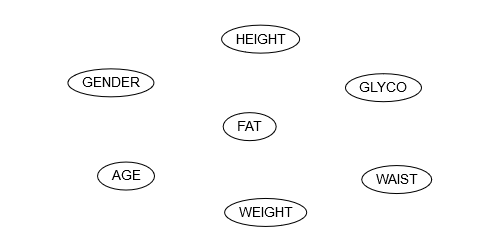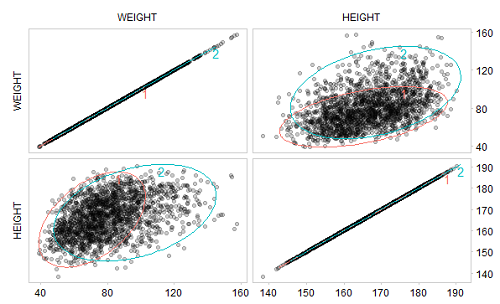

Gaussian mixture graphical models include Bayesian networks and dynamic Bayesian networks (their temporal extension) whose local probability distributions are described by Gaussian mixture models. They are powerful tools for graphically and quantitatively representing nonlinear dependencies between continuous variables. The R package gmgm provides a complete framework to create, manipulate, learn the structure and the parameters, and perform inference in these models.
The following example illustrates how gmgm can be used to learn the structure, the parameters and perform inference in a Gaussian mixture Bayesian network.
Let’s take the NHANES dataset provided in this package, which includes body composition data measured in 2148 adults aged 20 to 59 years in the United States. 1848 observations are randomly chosen as the training set, while the 300 remaining ones are chosen as the test set. In the latter, one-third of the values of each column are randomly removed:
library(gmgm)
set.seed(0)
data(data_body)
obs_train <- sample.int(2148, 1848)
data_train <- data_body[obs_train, ]
data_test <- data_body[setdiff(1:2148, obs_train), ]
data_test_na <- data_test
data_test_na$GENDER[sample.int(300, 100)] <- NA
data_test_na$AGE[sample.int(300, 100)] <- NA
data_test_na$HEIGHT[sample.int(300, 100)] <- NA
data_test_na$WEIGHT[sample.int(300, 100)] <- NA
data_test_na$FAT[sample.int(300, 100)] <- NA
data_test_na$WAIST[sample.int(300, 100)] <- NA
data_test_na$GLYCO[sample.int(300, 100)] <- NA
print(data_test_na)
#> # A tibble: 300 x 8
#> ID GENDER AGE HEIGHT WEIGHT FAT WAIST GLYCO
#> <int> <int> <int> <dbl> <dbl> <dbl> <dbl> <dbl>
#> 1 93731 0 NA NA NA 31.3 102. 4.9
#> 2 93758 NA 55 157. 75.8 NA 102. 6.5
#> 3 93761 NA 44 166. 80.2 31.8 NA 5.8
#> 4 93811 0 NA 164. 79.6 NA 90.9 5.3
#> 5 93814 1 41 169. NA 39.1 90.7 4.6
#> 6 93824 1 52 159. 72.2 41.1 87.4 5.6
#> 7 93837 1 NA 167. 109. 48.3 NA NA
#> 8 93841 1 48 172. 96.5 NA NA NA
#> 9 93849 1 40 165. 61.4 26 84.4 5.2
#> 10 93926 NA 31 NA NA 36.9 130. 5.3
#> # ... with 290 more rowsAt first, the Bayesian network is initialized with nodes corresponding to the variables of the dataset and no arc:
gmbn_init <- add_nodes(NULL,
c("AGE", "FAT", "GENDER", "GLYCO", "HEIGHT", "WAIST",
"WEIGHT"))
network(gmbn_init)
Starting from this initial structure, the training set is used to select the best subset of arcs (among predefined candidate arcs) and estimate the parameters of each local Gaussian mixture model:
arcs_cand <- data.frame(from = c("AGE", "GENDER", "HEIGHT", "WEIGHT", NA, "AGE",
"GENDER", "AGE", "FAT", "GENDER", "HEIGHT",
"WEIGHT", "AGE", "GENDER", "HEIGHT"),
to = c("FAT", "FAT", "FAT", "FAT", "GLYCO", "HEIGHT",
"HEIGHT", "WAIST", "WAIST", "WAIST", "WAIST",
"WAIST", "WEIGHT", "WEIGHT", "WEIGHT"))
res_learn <- struct_learn(gmbn_init, data_train, arcs_cand = arcs_cand,
verbose = TRUE, max_comp = 3)
#> node AGE bic_old = -1604165.22026861 bic_new = -6936.35703030545
#> node FAT bic_old = -1101157.27026861 bic_new = -5240.27043715568
#> node GENDER bic_old = -2188.72026861444 bic_new = 7570.83224030922
#> node GLYCO bic_old = -32261.7452686144 bic_new = -1351.77102746833
#> node HEIGHT bic_old = -25686922.7452686 bic_new = -6212.66741648412
#> node WAIST bic_old = -8931942.60026862 bic_new = -5573.47194798866
#> node WEIGHT bic_old = -6366683.95526861 bic_new = -7942.70714135656The final structure contains 11 arcs:
network(res_learn$gmgm)
If we focus for example on the variable WEIGHT, we can see that it directly depends on the variable HEIGHT. In the related local Gaussian mixture model, an optimal number of two mixture components has been selected:
print(res_learn$gmgm$WEIGHT)
#> $alpha
#> [1] 0.6200512 0.3799488
#>
#> $mu
#> [,1] [,2]
#> WEIGHT 70.78853 96.3321
#> HEIGHT 165.24341 168.4551
#>
#> $sigma
#> $sigma[[1]]
#> WEIGHT HEIGHT
#> WEIGHT 169.32464 57.37758
#> HEIGHT 57.37758 84.23874
#>
#> $sigma[[2]]
#> WEIGHT HEIGHT
#> WEIGHT 395.43744 64.55256
#> HEIGHT 64.55256 86.69264
#>
#>
#> attr(,"class")
#> [1] "gmm"Graphically, we observe that these mixture components fit well with the training data:
ellipses(res_learn$gmgm$WEIGHT, data_train)
Now that the Bayesian network has been learned, it can be used to perform inference on the test set, which allows to fill in the missing values:
data_infer <- inference(res_learn$gmgm, data_test_na)
print(data_infer)
#> # A tibble: 300 x 7
#> AGE FAT GENDER GLYCO HEIGHT WAIST WEIGHT
#> <dbl> <dbl> <dbl> <dbl> <dbl> <dbl> <dbl>
#> 1 31.7 31.3 0 4.9 173. 102. 88.4
#> 2 55 40.9 0.930 6.5 157. 102. 75.8
#> 3 44 31.8 0.145 5.8 166. 101. 80.2
#> 4 32.4 27.4 0 5.3 164. 90.9 79.6
#> 5 41. 39.1 1 4.6 169. 90.7 74.4
#> 6 52. 41.1 1 5.6 159. 87.4 72.2
#> 7 40.3 48.3 1 5.93 167. 119. 109.
#> 8 48 42.1 1 6.08 172. 111. 96.5
#> 9 40 26. 1 5.2 165. 84.4 61.4
#> 10 31. 36.9 0.00688 5.3 174. 130. 128.
#> # ... with 290 more rowsFocusing back on the variable WEIGHT, the values have been filled in with a mean absolute percentage error (MAPE) of 10.2%:
pred_weight <- data_infer$WEIGHT[is.na(data_test_na$WEIGHT)]
actual_weight <- data_test$WEIGHT[is.na(data_test_na$WEIGHT)]
mape <- mean(abs(pred_weight - actual_weight) / actual_weight)
print(mape)
#> [1] 0.101956